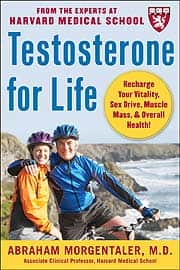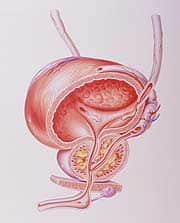Life Extension Magazine®
Millions of men needlessly suffer from low sex drive, loss of energy, and diminished enthusiasm for life—because of low levels of the male hormone testosterone. Normal levels can be readily restored using simple testosterone replacement therapy (TRT)—but in many audiences, those very words evoke the responses we commonly attribute to the hormone itself: rage, aggression, impulsiveness, and territoriality! Most physicians and many lay people continue to labor under a host of misconceptions, both about testosterone’s effects on human biology and behavior, and about the role of testosterone therapy in older adults. The truth is finally emerging, however, thanks largely to the efforts of Dr. Abraham Morgentaler of the Harvard Medical School, and a small number of equally dedicated clinician-scientists who have devoted their careers to understanding testosterone’s myriad effects on humans throughout the life span, and on building a fact-based, myth-busting approach to TRT, thus revealing its benefits and its risks. We recently had the opportunity to interview Dr. Morgentaler at length about his latest book, Testosterone for Life (McGraw-Hill, 2008),1 and about the exciting breakthroughs in men’s health and medicine for older adults in which he has participated. Morgentaler is no newcomer to this field—he’s a practicing urologist, an Associate Clinical Professor of Urology at the Harvard Medical School and the founder of Men’s Health Boston (a center focusing on sexual and reproductive health for men). The author of a number of books including The Male Body (Fireside, 1993) and The Viagra Myth (Jossey-Bass, 2003), Morgentaler has been working in men’s health, and particularly on the impact of testosterone, since he was an undergraduate student 30 years ago. It’s unusual for undergraduates to publish as a first author, especially in the field that turns out to be their life’s work—so we asked Dr. Morgentaler to take us back to 1978 and his original study in the journal Hormones and Behavior.2 Morgentaler laughed—“We were actually studying lizards, which have very elaborate and ritualized mating behaviors,” he recalled. “We were just beginning to learn about the powerful effects of testosterone on specific regions of the brain, and how it influences behavior.” To that end, Morgentaler and his mentor, Dr. David Crews, were working with lizards that had been castrated to remove any source of native testosterone. “Castration completely eliminated the mating displays in male lizards,” Morgentaler noted. “They were simply oblivious to females in their presence.” But when Crews and Morgentaler implanted testosterone in a very primitive brain center called the pre-optic area, the mating ritual was restored completely!2 “What was particularly remarkable about this,” Morgentaler continued, “was that these effects were purely local—we didn’t see any increase in blood testosterone levels. This showed us that testosterone has very precise, very specific effects on highly complex behaviors that originate deep in the brain.” The pre-optic area is responsible for many aspects of reproductive behavior in humans as well,3 and in fact the interaction of testosterone with the brain is a fundamental fact throughout the animal kingdom. Intrigued by all this, Dr. Morgentaler set out on a lifetime of discovery. Let’s be “armchair travelers” on the high points of his journey. Testosterone and Aging: Why Should We Care?
“The first question to be asked in thinking about testosterone in humans is ‘Why should we care?’” Morgentaler began. “Among men more than 45-50 years old, the prevalence of low testosterone is at least 20-30%,” he continued (that’s an estimated 2 to 4 million men in the US alone!).4 “Many people (highly-respected physicians among them) have long believed that levels decline as a natural consequence of advancing age,5,6 and that therefore there is nothing we can or should do about it,” he went on. “That’s like telling a middle-aged person that since vision typically deteriorates with age, there’s no point in prescribing glasses—or that we shouldn’t treat atherosclerosis to prevent heart attacks, because it too is an age-related phenomenon. It just doesn’t make sense!” How can a man know if he has low testosterone levels (or as Dr. Morgentaler calls it, “Low T”)? “Not every man with low T will have symptoms,” Morgentaler responded, “though many people with symptoms aren’t aware that they have low T. Because of their lack of understanding of the problem, compounded by some genuinely erroneous data that have been misquoted or overstated for decades, most doctors don’t regularly check testosterone levels—so many men go on suffering, undiagnosed.” “In my practice, of course I see men whose complaints are primarily sexual: diminished drive and interest in sex, but also poor performance and absent or unsatisfying orgasms.” But low T also affects mood and behavior outside the bedroom. “I also find a very large number of men whose complaints are non-sexual in nature: they have chronic fatigue, they feel tired, lack energy and focus; they seem to have lost much of the drive that made them the men they thought they were (and liked to be).” As one of Dr. Morgentaler’s patients put it eloquently, “it feels like I have ‘brain fog’ all the time.” Physical performance can suffer as well. Many patients complain that it takes much longer to “recharge” after exertion. “They tell me they just feel dead after what was once a normal workout,” Morgentaler reports, “or they say that they just can’t seem to improve with progressive training. That makes a lot of sense since we know that reduced testosterone levels contribute to loss of muscle bulk and strength, as well as to increased fat stores.”5,7 Millions of men needlessly suffer from low sex drive, loss of energy, and diminished enthusiasm for life—because of low levels of the male hormone testosterone. It isn’t just the men themselves who perceive these gradual changes—in fact, frequently their wives and partners see the problems most clearly, especially when it comes to mood and behavior. “I sometimes ask a man if he feels crankier or more short-tempered than he used to,” Morgentaler relates. “Often the guy will say ‘No, not really,’ but his wife will exclaim ‘Oh my gosh yes, that’s exactly what’s going on! I thought it was just me!’” That seemed paradoxical—doesn’t testosterone cause men to have a short fuse, to be ready for a fight, and to be reactive? “That’s just one of the many misconceptions about testosterone,” said Morgentaler. “It probably comes from widespread public knowledge about athletes who take a variety of steroid hormones at unnaturally high levels.8 In fact we find that men who’ve become nastier as their T levels dropped actually stabilize their moods with replacement therapy.” Researchers at Germany’s Institute of Reproductive Medicine recently provided some independent support for this observation, noting that “testosterone substitution can increase positive mood and decrease negative mood.”9
But there are less obvious reasons to be concerned about declining testosterone levels—reasons that relate to total body health, not just behavior and performance, sexual or otherwise. According to Canadian expert Dr. Jerald Bain, “Testosterone is more than a ‘male sex hormone.’ It is an important contributor to the robust metabolic functioning of multiple bodily systems.”8 Dr. Morgentaler concurs, vehemently. “Testosterone stimulates and maintains muscle and bone growth, for example—many men don’t realize that low T puts them at increased risk for osteoporosis with advancing age. It also stimulates red blood cell production, helping to prevent anemia.” Testosterone levels are reduced in type 2 diabetes and the metabolic syndrome, and although cause and effect remain unclear, therapy with testosterone in these conditions can reduce LDL cholesterol, blood sugar, glycated hemoglobin, and insulin resistance.8,10,11 Finally, Morgentaler notes, “Men with low T die earlier than those with normal T.”7,12 That alone is ample reason to take notice. Summarizing the “Why should we care” question, Dr. Morgentaler said, “If I told you of a known medication that can improve mood and performance, while reducing the risks for a host of chronic, apparently age-related conditions, and has the real potential for increasing longevity, you would jump at it. Well, there’s solid evidence for all of that with responsible TRT. Men who feel old, have decreased ‘get up and go,’ and diminished sex drive may not simply be ‘getting old;’ they may be suffering from a treatable hormone deficiency.” The good news is that Morgentaler believes there’s a growing awareness of this issue, both among lay people and physicians: “I predict that within 5-10 years primary care physicians will be checking T levels routinely, and that men will know their T levels just like they know their cholesterol and PSA levels today.” Obstacles to Acceptance of T Replacement TherapyWhy will it take even that long for such a successful approach to become mainstream? “There are three fundamental obstacles to widespread acceptance of TRT,” Morgentaler observed. “The first is that the benefits, though clear, have not been as well-documented in the literature as they should be, and therefore physicians simply don’t get a chance to learn as much as they could. Paradoxically, testosterone was ‘grandfathered’ into approval by the FDA years ago, so its benefits weren’t as rigorously demonstrated as would be required today. That means that, until recently, physicians didn’t have a large body of evidence to turn to. Fortunately, that’s changing with an increased number of studies on the subject.” In fact, by 2004 Dr. Morgentaler and a colleague found sufficient data to write a review article for the New England Journal of Medicine in which they provided the kind of summary that modern physicians need in order to best understand both the benefits and the possible risks of TRT.4 “Another obstacle to acceptance is that the diagnosis of testosterone insufficiency has been and is confusing to people both within and outside of medicine,” Morgentaler continued. “One of the main benefits I hope that my book will provide is to help individuals and their physicians to decide if low T is actually present or not. Some of this confusion has had to do with lack of awareness, some with lack of understanding of the various ways of measuring testosterone, and some with variations in the standards that laboratories use in reporting it.” “The last, and possibly greatest, hurdle to overcome is the persistent idea that TRT causes prostate cancer,” Dr. Morgentaler went on. “As I point out in my book, this concept turns out to be based on a very few, very sketchy, and very old reports, most of which have also been very inaccurately cited—but cited so frequently that they’ve taken on the aura of truth. In fact, while prostate cancers do usually need testosterone to grow, there’s interesting laboratory evidence that prostate cancer cells behave less aggressively in the presence of testosterone than they do without it, suggesting that normal levels of testosterone may even turn out to be beneficial for men with prostate cancer.13 “Fortunately,” Dr. Morgentaler concluded, “all of these barriers are now relaxing, as it becomes clear how many body systems rely on healthy, normal T levels, and how normal T levels contribute to prevention of cardiovascular disease, diabetes, and the metabolic syndrome.”10,14 | |||
Making the DiagnosisWith the growing number of scholarly articles on T replacement therapy helping physicians and lay people alike overcome the knowledge barrier, the next step is clarifying the diagnosis. The most important clues come from the patient’s own history. “When I hear a man say ‘The sofa speaks to me,’ I am concerned,” Dr. Morgentaler said. “So often I hear variations on that theme—men just find that their new ‘normal’ level of activity is much lower than it used to be. They have trouble focusing, staying on top of their game. I see men from all walks of life, often those whose careers have been built on being sharp, on asking incisive questions, on making snap decisions—and they’re finding they just have trouble doing those things.” As we’ve seen, mood can also be affected—it’s well known that men with low T are more prone to depression.15 “Beyond depression, my patients also frequently complain of dramatic mood swings,” Morgentaler noted. Blood levels are an important part of the diagnostic process too—but it isn’t entirely black and white. “While we currently don’t recommend that every man undergo regular testosterone checks as a screening test,” Morgentaler noted, “We do need to get primary care doctors thinking about the diagnosis in an increasingly broad way. Men who complain of fatigue, poor focus, and low energy levels, in addition to those with purely sexual complaints, should have their T levels checked. Not all will have low T, of course, but we know that we’re missing a very large number of people at present.”
As with any other blood test, it’s important to know what the “normal” levels are, and how they apply to an individual. “According to the FDA, “a ‘normal’ total T level is 300 ng/dL,” says Morgentaler. “Strictly interpreted that would mean that a man with a level of 299 is low, while a man with a level of 301 is normal. That’s simply not a sensible approach. The Endocrine Society, a very august group, has produced guidelines that mirror the FDA, though they do point out that no single number should be used and that symptoms should guide the diagnosis.16 The International Society for the Study of the Aging Male17 uses a higher number, 348. The point is that we need to interpret these numbers in the context of a man’s signs and symptoms.” In other words, if a man’s symptoms are consistent with low T and his level is anywhere near the low end of these scales, he and his physician should consider a trial of T replacement therapy. According to Dr. Morgentaler, “Which tests are done, where they are done, and how they are reported also matter. Most primary care physicians use local laboratories, which can be inaccurate and arbitrary in their ‘normal’ reporting range. We pulled 25 hospital laboratories’ reference ranges at random, and found 17 different low and high ‘normal’ values.” Worse, none of these values were based on symptoms—they were based simply on standard deviation from average levels in the population. “In a population with 10% of men with truly low T levels, this approach means you’d miss three-quarters of them with standard testing,” Morgentaler points out. This can have significant impact when a primary care physician, appropriately concerned about the possibility of low T, gets back a “normal” result and falsely concludes that the problem lies elsewhere.
“A more rational approach, and one we’ve taken with other blood tests such as cholesterol, glucose, and PSA, is to establish healthy target levels based on the literature,” continued Morgentaler. “That way we have an objective measure that actually says something about a person’s risk for a particular outcome.” Physicians may also need some reminding about which test to order for testosterone. Like other sex hormones, testosterone is found in the blood largely bound to a protein called sex hormone-binding globulin, or SHBG.10 But it’s the “free” testosterone that actually affects risk and performance, and standard testing measures only total T (free plus bound). “Physicians need to order both total and free T levels when they do their testing,” says Morgentaler. “If either one is low or in the ‘low normal’ range in a man with symptoms consistent with low T, then treatment should be considered.” Do doctors need to send this test out to specialized labs? “Not at all,” responded Dr. Morgentaler. “Most labs can do both tests—physicians just have to know to order them.” So You Have Low T—What Can Be Done About It?Fortunately, once the diagnosis has been made on the basis of concerning symptoms and low or low-normal T levels, treatment is fairly straightforward. “We have many options for treatment of men with low T,” Dr. Morgentaler observed. “There’s no recommended pill available in the US—there are some old ones still around that are not very effective and they are associated with significant liver toxicity, so no one should be using them for TRT.” But just about every other route has been explored. “I usually start a man on a fairly short-acting form of T replacement,” Morgentaler continued, “so that we can gauge the effects together and make adjustments as needed. The market leader in this area is the testosterone gel, which is easy to use and has minimal skin reactivity. A man just showers, dries, and then applies the gel to the upper arms or shoulders. It’s absorbed very rapidly, so there’s no need to cover the area with a dressing of any kind. Men like the gel because it’s convenient, and we like it because it delivers reliable blood levels of testosterone quickly.” The gel will probably replace the still-available transdermal patch, still in use especially by the Veterans Administration. “The patch is easy to use, but it causes a significant amount of skin irritation,” says Dr. Morgentaler, “and it doesn’t produce great blood testosterone levels.” There’s also the injection route—an intramuscular shot given every 2 weeks. “The advantage,” Morgentaler notes, “is that we always get adequate levels this way—but of course it requires biweekly shots which most people don’t like.”
In a revival of an old technique (remember the lizard experiments), time-release implants are now available as well. “These are inserted just under the skin in the buttocks—we use 8-10 rice grain-sized pellets that slowly release T into the circulation. They produce great levels, there’s no ongoing maintenance required, and they are fully-absorbed, so never need to be removed,” says Morgentaler. Finally, in terms of readily-available options, there are oral pastiches—tiny tablets that are placed between the cheek and gum. “They’re not visible to others,” Dr. Morgentaler points out, “and you just switch them every 12 hours.” These may be a good option for men who are uncomfortable with gels, injections, or implants. What’s on the horizon? “A long-lasting injectable form of testosterone, called testosterone undecanoate, may soon be available—if approved by the FDA it will be called Aveed™ (it is known as Nebido® outside the US), and it is good for 2.5 months. This product is ideal for men who’ve had a favorable response to treatment, and just want to continue with good T levels without having to fuss with other dosing forms,” Dr. Morgentaler remarked. What about side effects? “Testosterone therapy is safe,” Dr. Morgentaler stressed, “because unlike most pharmaceuticals, testosterone is a naturally occurring product of a man’s body. The replacement hormone is identical to endogenous testosterone. We see fairly minimal side effects of appropriate treatment: some minor swelling and tenderness of the breasts, and occasionally some acne breakouts occur. T therapy may also cause elevation of red blood cell counts, but there have been no reports of stroke or other related adverse effects.4 An important consideration, though, is that production of sperm will decrease during treatment, and testicular size may also decrease. All reported side effects go away as soon as treatment is stopped, which is also reassuring.” And unlike the effects seen in body builders who use high-dose androgen injections that include non-testosterone hormones, “T therapy doesn’t cause kidney, liver, or cardiovascular disease. We monitor our patients by checking their T and PSA levels, examining their skin and breasts periodically, and checking blood counts once or twice yearly,” says Morgentaler. T Therapy and Prostate CancerWith diagnosis simplified and so many safe treatment options available, why are only about 5% of men with low T getting appropriate care?4 There’s a persistent fear of prostate cancer, and the belief that T therapy causes the disease continues to influence physicians and patients alike. “Most of my research and scientific writing has been on the purported relationship between T therapy and prostate cancer,” Dr. Morgentaler said. “The concerns have a historical basis—it’s long been known that reducing testosterone or its effects in men with metastatic prostate cancer makes the cancers smaller and slows their growth. That, perhaps naturally, led to the assumption that increasing testosterone would make the cancers larger and speed their growth.” But in the past ten years, Morgentaler and other scientists have been aggressively challenging that assumption. “Long-term studies looking for increased incidence of prostate cancer in men with naturally high T levels have consistently failed to show any relationship at all,” notes Morgentaler. “Other studies showed that PSA was unchanged in men who received treatment that increased their T levels to more than twice the ‘normal’ range.” In fact, Dr. Morgentaler has published data showing that men with significant reductions in testosterone levels actually have an increased risk for prostate cancer!18 Other world-class researchers have become interested. A “pooled data” study by dozens of scientists in the Endogenous Hormones, Prostate Cancer Collaborative Group and published in the Journal of the National Cancer Institute reviewed 18 prospective studies that included 3,886 men with prostate cancer and 6,438 control subjects.19 The studies had all evaluated the risk of prostate cancer and levels of total and free testosterone as well as other sex hormones. The conclusion? “In this collaborative analysis of the worldwide data on endogenous hormones and prostate cancer risk, serum concentrations of sex hormones were not associated with the risk of prostate cancer.” “More and more placebo-controlled studies are showing no increase in prostate cancer in men actually receiving T therapy,” Dr. Morgentaler noted. “So far these are only short-term studies because we just haven’t been doing it long enough,” he continued, “but the longitudinal studies are so strong that I believe the question has been answered firmly.” Does T therapy cause increases in PSA (the marker for early prostate cancer)? “There’s no difference between PSA ‘trigger events’ (PSA over the threshold of 4 ng/dL) in men receiving T replacement and those who aren’t,” Morgentaler said, citing data both from his own work20 and another pooled meta-analysis study.21 Based on the overwhelming wealth of data, Dr. Morgentaler is now beginning to provide T replacement therapy to men who’ve had prostate cancer—something that would have been anathema just a few years ago.22 Other experts are beginning to follow suit.23,24 Even more impressively, Morgentaler and his colleague Emani Rhoden at Harvard have also begun T therapy in men at high risk for prostate cancer—men who have biopsy-proven prostatic intraepithelial neoplasia (PIN), which is considered to be a precancerous condition.25 This is more than just good science—Morgentaler’s work is providing improved quality of life for men who thought they’d seen the last of their male vigor. “I saw an 84-year-old man with prostate cancer,” recalls Morgentaler. “He wasn’t interested in treating the cancer at his age, and he wanted T therapy because he was interested in the benefits. Two years later he’s actually seen a decrease in his PSA levels, and more importantly, he feels great!” Cautionary note: Although quite a number of urologists and oncologists will now offer TRT to men with a history of prostate cancer, primarily after successful treatment of the cancer, many others are still concerned that treatment may increase the risk of cancer recurrence. And language mandated by the FDA for all commercial testosterone products advises against using TRT in men with any history of prostate cancer. The field still awaits large studies to determine the degree of safety of TRT in men with prostate cancer. SummaryDr. Morgentaler closed our discussion with this summary of where we are with T replacement therapy: “Low T is common—much more so than most people realize. It has effects far beyond the very important impact on sexual function; in fact low T is associated with everything from atherosclerosis to the metabolic syndrome to male osteoporosis. And men with low T simply don’t feel good, and they don’t know why. Low T is vastly under-treated, yet T replacement therapy is safe and rapidly effective—we typically see results within weeks of starting treatment. I believe that any man over the age of 50 who feels run-down, off his game, or has any of the other symptoms of low T owes it to himself and his family to have his T levels checked, and if they are low, to be treated.” The final words in Morgentaler’s book say it eloquently: “We always have choices when it comes to our health. For many men with low T, learning about the condition and finding help to treat it is a good choice—a choice for life.”1 If you have any questions on the scientific content of this article, please call a Life Extension® Wellness Specialist at | |||||
| References | |||||
| 1. Morgentaler A. Testosterone for Life. New York: McGraw-Hill; 2008. 2. Morgentaler A, Crews D. Role of the anterior hypothalamus-preoptic area in the regulation of reproductive behavior in the lizard, Anolis carolinensis: implantation studies. Horm Behav. 1978 Aug;11(1):61-73. 3. Dominguez JM, Hull EM. Dopamine, the medial preoptic area, and male sexual behavior. Physiol Behav. 2005 Oct 15;86(3):356-68. 4. Rhoden EL, Morgentaler A. Risks of testosterone-replacement therapy and recommendations for monitoring. N Engl J Med. 2004 Jan 29;350(5):482-92. 5. Harman SM, Metter EJ, Tobin JD, Pearson J, Blackman MR. Longitudinal effects of aging on serum total and free testosterone levels in healthy men. Baltimore Longitudinal Study of Aging. J Clin Endocrinol Metab. 2001 Feb;86(2):724-31. 6. Morley JE, Kaiser FE, Perry HM 3rd, et al. Longitudinal changes in testosterone, luteinizing hormone, and follicle-stimulating hormone in healthy older men. Metabolism. 1997 Apr;46(4):410-3. 7. Shores MM, Matsumoto AM, Sloan KL, Kivlahan DR. Low serum testosterone and mortality in male veterans. Arch Intern Med. 2006 Aug 14-28;166(15):1660-5. 8. Bain J. The many faces of testosterone. Clin Interv Aging. 2007;2(4):567-76. 9. Zitzmann M. Testosterone and the brain. Aging Male. 2006 Dec;9(4):195-9. 10. Kupelian V, Page ST, Araujo AB, Travison TG, Bremner WJ, McKinlay JB. Low sex hormone-binding globulin, total testosterone, and symptomatic androgen deficiency are associated with development of the metabolic syndrome in nonobese men. J Clin Endocrinol Metab. 2006 Mar;91(3):843-50. 11. Traish AM, Saad F, Guay AT. The dark side of testosterone deficiency: II. Type 2 diabetes and insulin resistance. J Androl. 2009 Jan-Feb;30(1):23-32. 12. Shores MM, Moceri VM, Gruenewald DA, Brodkin KI, Matsumoto AM, Kivlahan DR. Low testosterone is associated with decreased function and increased mortality risk: a preliminary study of men in a geriatric rehabilitation unit. J Am Geriatr Soc. 2004 Dec;52(12):2077-81. 13. Chuu CP, Hiipakka RA, Fukuchi J, Kokontis JM, Liao S. Androgen causes growth suppression and reversion of androgen-independent prostate cancer xenografts to an androgen-stimulated phenotype in athymic mice. Cancer Res. 2005 Mar 15;65(6):2082-4. 14. Tenover JL. Testosterone replacement therapy in older adult men. Int J Androl. 1999 Oct;22(5):300-6. 15. Pope HG, Jr., Cohane GH, Kanayama G, Siegel AJ, Hudson JI. Testosterone gel supplementation for men with refractory depression: a randomized, placebo-controlled trial. Am J Psychiatry. 2003 Jan;160(1):105-11. 16. Bhasin S, Cunningham GR, Hayes FJ et al. Testosterone therapy in adult men with androgen deficiency syndromes: an endocrine society clinical practice guideline. J Clin Endocrinol Metab. 2006;91:1995-2010. 17. Lunenfeld B, Saad F, Hoesl CE. ISA, ISSAM and EAU recommendations for the investigation, treatment and monitoring of late-onset hypogonadism in males: scientific background and rationale. Aging Male. 2005;8:59-74. 18. Morgentaler A, Rhoden EL. Prevalence of prostate cancer among hypogonadal men with prostate-specific antigen levels of 4.0 ng/mL or less. Urology. 2006 Dec;68(6):1263-7. 19. Roddam AW, Allen NE, Appleby P, Key TJ. Endogenous sex hormones and prostate cancer: a collaborative analysis of 18 prospective studies. J Natl Cancer Inst. 2008 Feb 6;100 (3):170-83. 20. Rhoden EL, Morgentaler A. Influence of demographic factors and biochemical characteristics on the prostate-specific antigen (PSA) response to testosterone replacement therapy. Int J Impot Res. 2006 Mar-Apr;18(2):201-5. 21. Calof OM, Singh AB, Lee ML et al. Adverse events associated with testosterone replacement in middle-aged and older men: a meta-analysis of randomized, placebo-controlled trials. J Gerontol A Biol Sci Med Sci. 2005 Nov;60(11):1451-7. 22. Morgentaler A. Testosterone therapy for men at risk for or with history of prostate cancer. Curr Treat Options Oncol. 2006 Sep;7(5):363-9. 23. Agarwal PK, Oefelein MG. Testosterone replacement therapy after primary treatment for prostate cancer. J Urol. 2005 (Feb);173(2):533-6. 24. Sarosdy MF. Testosterone replacement for hypogonadism after treatment of early prostate cancer with brachytherapy. Cancer. 2007 Feb1;109(3):536-41. 25. Rhoden EL, Morgentaler A. Testosterone replacement therapy in hypogonadal men at high risk for prostate cancer: results of 1 year of treatment in men with prostatic intraepithelial neoplasia. J Urol. 2003 Dec;170(6 Pt 1):2348-51. |






